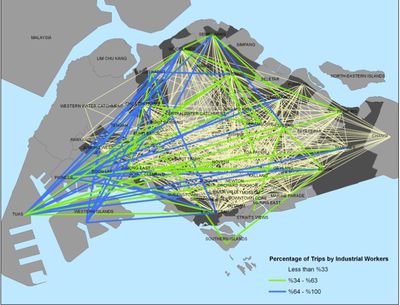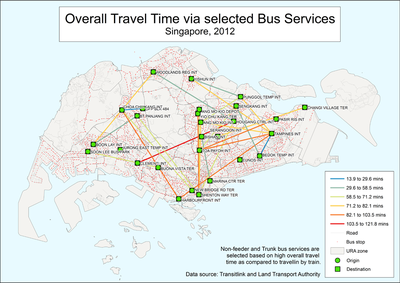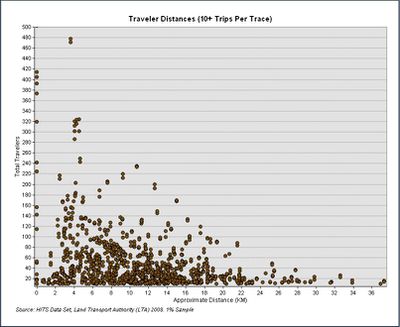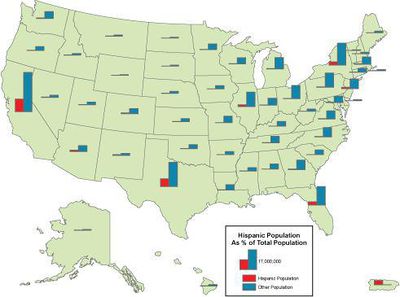Difference between revisions of "JJJ: Proposal"
| Line 83: | Line 83: | ||
<p><center>'''Source''': https://www.e-education.psu.edu/natureofgeoinfo/c3_p17.html </center></p> | <p><center>'''Source''': https://www.e-education.psu.edu/natureofgeoinfo/c3_p17.html </center></p> | ||
|| | || | ||
| − | * To show the proportion of people travelling out | + | * To show the proportion of people travelling out/within each region |
| − | * Bar charts will be generated on each region of the map | + | * Bar charts will be generated on each region of the map e.g. East |
* Each Bar chart represents the proportion of people travelling Interregion (East-West, East-North, etc) and within region (East-East) | * Each Bar chart represents the proportion of people travelling Interregion (East-West, East-North, etc) and within region (East-East) | ||
* Can add in more analysis by binning the journey start time to morning, afternoon and night as filters to show commuter flow by time period of day | * Can add in more analysis by binning the journey start time to morning, afternoon and night as filters to show commuter flow by time period of day | ||
| − | * To provide | + | * Interactive visual that can be used with brushing to highlight and narrow down to area of interest |
| + | * To provide for easy and intuitive understanding of existing commuter patterns | ||
|- | |- | ||
Revision as of 17:19, 7 October 2016
Proposal
|
Contents
Problem & Motivation
Land scarcity is persistent issue faced by Singapore since its independence, being a country with only the size of a typical city or smaller of a fellow developed nation. As such, one of Singapore’s main challenges is in the area of Urban Planning to optimize land use without compromising on the standards of living for its residents.
One of the ways to assess the effectiveness of urban planning would be to study commuter patterns, understanding how people travel for their work and educational needs. Some who stay near to their workplace enjoy a shorter journey with less commuting time. However, there are also people who stay far from their workplaces and spend long hours on travel, for example an individual who stays at Tampines yet having to travel to Tuas for work. Hence, we would like to create a tool to gain a closer look into commuter patterns in Singapore to find out more on current commuter patterns. We believe that the tool in investigating commuter patterns would be useful for urban planners to be able to identify potential problems and patterns in the current design so as to improve the urban landscape in preparation for population growth.
Objectives:
- To explore recent commuter data for bus travel in Singapore
- To visualize commuter patterns during the morning peak hours
- To explore the impact of current commuter patterns on possible challenges in urban planning
- To create a visualization for an easy and intuitive understanding of the current situation for the average Singaporean
Background Survey of Related Work
| Related Works | What We Can Learn Based on Sources |
|---|---|
|
|
|
| |
|
Choice of Dataset
Data Source: https://data.dex.sg/organization/land-transport-authority
- Preparation of Data
We downloaded a total of 8 CSV files which consists of commuter and bus data from the data source above. The main dataset provides an extensive number of up to 1,000,000 commuter records and needs careful analysis of what we need. Here is a list of attributes that are of our concern when cleaning the data:
- Commuter ID
- Ride Start Time
- Ride End Time
- Boarding Bus Stop
- Alighting Bus Stop
- Bus Service Number
Other datasets provides us more attributes such as the coordinates of the bus stops
Description of the approach
| Type of Visual | Why do we think it is useful |
|---|---|
|
|
|
References
- http://worksingapore.com/articles/live_4.php
- https://www.lta.gov.sg/content/dam/ltaweb/corp/PublicationsResearch/files/ReportNewsletter/LTMP2013Report.pdf
- https://www.quora.com/In-Singapore-it-takes-more-than-an-hour-to-reach-a-destination-via-the-public-transport-bus-train-but-just-quarter-of-the-time-if-I-were-to-take-the-taxi-Would-we-still-call-the-public-transport-successful
- http://web.mit.edu/11.521/papers/WorkingSocialDocument_Aug2012_v2.pdf
- http://www.enterpriseinnovation.net/article/singapores-transport-vision-analytics-new-interfaces-autonomous-vehicles-1298824564
- http://business.asiaone.com/career/news/3-factors-determine-if-singaporeans-leave-their-jobs
- http://community.jobscentral.com.sg/articles/your-daily-work-commute-ruining-your-life
- http://blog.moneysmart.sg/lifestyle/cheap-fast-and-painless-commuting-in-singapore-is-it-possible/
- http://lkyspp.nus.edu.sg/wp-content/uploads/2014/01/Transport-Planning-for-Singapore.pdf
- http://lkyspp.nus.edu.sg/wp-content/uploads/2013/04/Barter-Sg-urban-transport-sustainable-by-design-or-necessity.pdf
- https://www.ura.gov.sg/uol/master-plan/view-master-plan/master-plan-2014/Growth-Area
- http://www.smartnation.sg/initiatives/Mobility/spearheading-research-in-standards-for-sdvs
- https://www.ura.gov.sg/skyline/skyline09/skyline09-02/text/04.htm
Key Technical Challenges
Milestones
Test
Comments
Please feel free to comment on our proposal.



